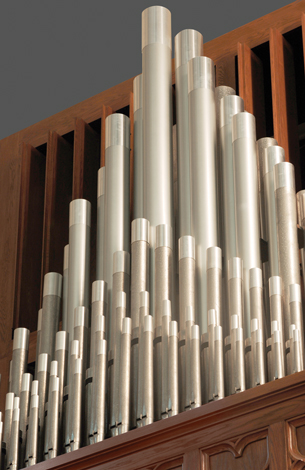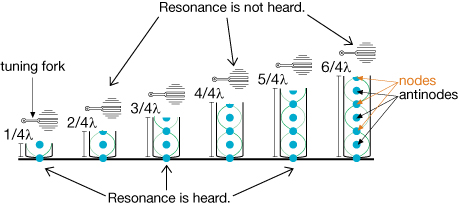Module 8—Mechanical Waves
 Explore
Explore

© James Steidl/shutterstock
The organ pipes seen here sit on top of a windchest. The windchest is connected by wind trunks (large tubes) to a reservoir of lightly compressed air. When the musician presses a key on the keyboard, valves open and air escapes from the windchest. This moving air acts on specific pipes. The airflow and the design of the pipe cause the pipe and the air in the pipe to vibrate. A standing wave that is specific to the dimensions of that pipe is produced.
Each pipe encloses an air column of specific length that is capable of holding a standing wave pattern as long as the windchest supplies moving air. There are two types of air column—a closed one, where one end of the air column is sealed so that waves are reflected, and an open one, where both ends of the air column are open.
If you are interested in learning more about the workings of pipe organs, search on the web for “Pipe Organ Education Project.”
Closed-air Column Resonance
Although sound waves are longitudinal waves, they will be represented here as transverse waves simply for the purpose of visualizing them inside an air column.
Consider six closed-air columns with different lengths, as shown below. A tuning fork is struck and then held over the opening of each air column. Three of the air columns resonate, which is observed as an amplification of the sound produced by the tuning fork. Three do not resonate—only the sound of the tuning fork can be heard at the top of each of these air columns. Why the difference?

When the sound wave enters the column at the opening, it travels downward, reflecting from the bottom surface. The reflected wave encounters more incoming waves, and a standing wave pattern is produced (shown in green). Identifying the nodes and antinodes in the pattern indicates that a closed-air column will resonate loudly when an antinode (point of complete constructive interference) is at the opening of the air column. This occurs when the air column length is one-quarter that of the wavelength and then again every
one-half wavelength ![]()

If the length of the air column is adjusted so that a node (point of complete destructive interference) is at the opening, no sound will be heard coming from the air column. This occurs when the air column length is a multiple of one-half the wavelength ![]()
Closed-air column resonance is heard when an antinode exists at the opening of the air column. This occurs when the air column is ![]() and so on. Expressed as an equation, it is
and so on. Expressed as an equation, it is ![]() and so on.
and so on.
| Quantity | Symbol |
SI Unit |
length |
L |
m |
wavelength |
λ |
m |